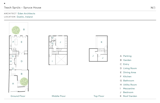Construction Diary: An Irish Architect’s Passive House Shows the Strength of Cross-Laminated Timber
Dublin’s Portobello neighborhood has a checkered history. Built on a picturesque canal, it began life in the 18th century as a small suburb on the southern edge of the city. Later, it was nicknamed "Little Jerusalem" on account of its thriving Jewish community. Just a few decades ago, it was a rough-and-ready residential district, full of low-budget bedsits and old-school groceries.
These days, the traditional stores have mostly been replaced by trendy eateries—to such an extent that that the area was dubbed a "culinary hotbed" in a 2017 New York Times article, much to the surprise of many local residents.
Portobello holds a special place in the heart of architect John-Barry Lowe, of Dublin’s Eden architects, who grew up on nearby Baggot Street and went on to live in several house shares in the neighborhood before moving away. In 2023, he moved back with his wife, Carol, and two daughters, having finally constructed his own house in one of the laneways off the terraced streets the area is famous for.
Location was important, but John-Barry’s priority was to find a brownfield site, and to build a home from scratch using cross-laminated timber (CLT) that would meet the requirements of the Passive House Institute, without the constraints of renovating a historic house.
Seeking Out a Site
John-Barry Lowe: I’ve lived all over Dublin, but I was always happiest in the neighborhoods set inside the city’s canals. I knew the lane where we ended up building our house from around 15 years ago when I’d looked into buying a site here. So when I spotted a mechanic’s garage for sale with planning permission for a house, my immediate thought was "we have to get it." I’d been looking for something like this for 20 years, and I’m not getting any younger!
We bought the plot in 2020, literally the week before Covid started, and we moved in July 2023, even though it wasn’t finished. In all, it took about four and a half years to complete.
I wanted to build a kind of protoype home. I thought, "If I’m going to build a new house, I’d like it to be something people could copy, and maybe use as a model to build streets or even whole neighborhoods." I was always taken with the Case Study Houses in the U.S.—and Passive House and CLT are two sustainable design approaches that piqued my interest.
The Wonders of Wood
JBL: I teach architecture at University College Dublin, and came across CLT doing research for my students. Aesthetically it’s interesting, because it allows you to create walls and ceilings made of wood. I also liked the idea of solid construction, where there’s no air or voids in the building. The other thing about CLT is that it’s very thin, but still very strong. The walls with CLT on the inner line are thinner than the equivalent masonry construction, which allowed me to make more use of the internal footprint of the house—effectively making it wider.
The real strength of CLT is that you can build five- or ten-story carbon-neutral apartment buildings using timber. I thought, "If they are ever to build apartments with CLT in Ireland, seeing a house that uses it would be a start."
Passive House Principles
JBL: Passive House is much older, and when it was invented in the late 1980s-early 1990s, the concern wasn’t that the planet would overheat, it was that we would run out of oil. It’s a very energy-efficient standard, and it’s all about comfort, good-quality air, and ventilation. What makes it so successful is that it’s very accurate. When you use Passive House software to design a house, it predicts the way the house will perform—from what size of heating system is needed to how much energy it will use.
The warm interior aesthetic combines exposed CLT with painted brick and lime-rendered or painted plasterboard in varying shades of blue and green. The latter are strategically used to conceal services, such as a mechanical heat recovery ventilation system that ensures comfort in each space year-round.
A Day in the Life
JBL: The whole family likes to congregate and just kind of bump into each other on the spacious ground floor with the bright living space at the front and the kitchen at the back. My daughters love playing and singing, and I believe that if things aren’t visible or easy to get, you won’t use them. So for the kids to play or for us to cook, the toys and the food need to be visible.
What I love most about the house is the outdoor spaces—two on the ground floor and one on the on the roof. They’re like a sort of a framing device between the rooms and the sky, setting the scene. In the double-height front room, the sunlight doesn’t come in during summer, but in winter it comes in deeper and deeper and lower and lower. I just love the way nature and the outdoor spaces interact with the indoor spaces of the house.
More Construction Diary stories:
In Chile, a Much-Needed Addition Feels a Part of the Landscape
A Couple Create a Multigenerational Haven in Los Angeles
An Architect Relies on Memory to Rebuild His Childhood Home
Project Credits:
Architect of Record: Eden Architects
Builder/General Contractor: Marr Construction
Structural Engineer: Furness Partnership
Civil Engineer: RB Consulting Engineers
Landscape, Lighting, and Interior Design: Eden Architects
Cabinetry Design/Installation: Hanrahan Joinery
Cross-Laminated Timber Contractor: G-frame
Passive House Consultant: Passivate
Published
Last Updated
Get the Dwell Newsletter
Be the first to see our latest home tours, design news, and more.











